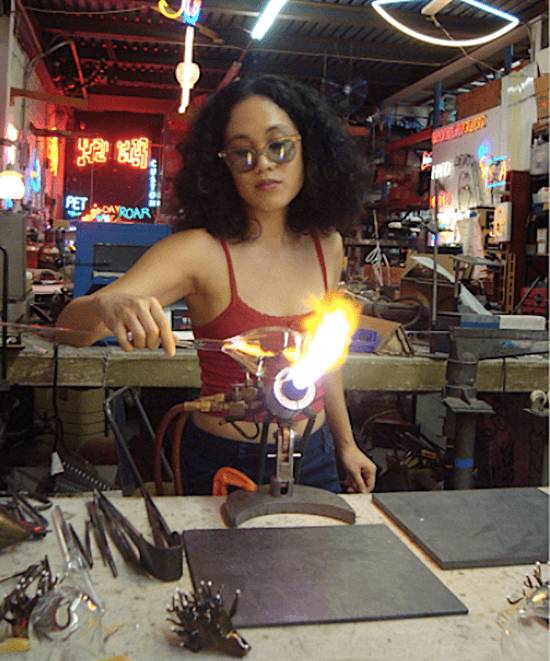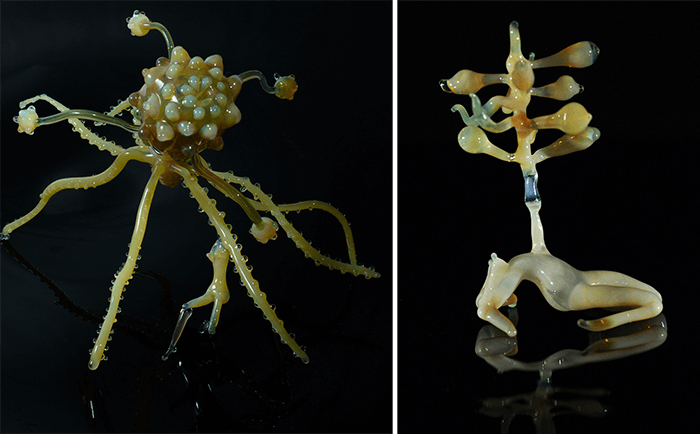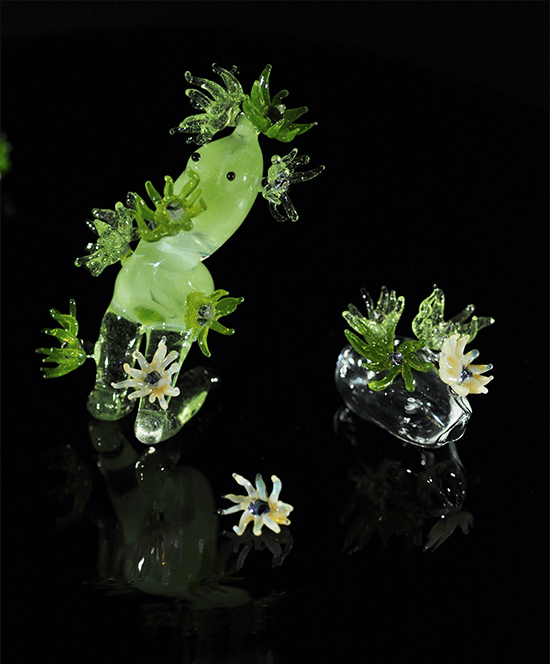A glass menagerie inspired by Medusa
The glass pieces created by Goldie Poblador are fragile; delicate, even. But she is not. Based in New York, she admits the city is “tough” for an artist. “Personally, in 2023 I was feeling like I was fighting for survival, you know.” That fight was literal: she recalls being struck in the face by rampaging New York males on April 1 of that year, an attack she still grapples with through her art. But the UP and Rhode Island School of Design (RISD) graduate has toughed it out, show after show, building on her original vision: fusing a technique called lampworking—melting borosilicate glass to create delicate-looking, sinuous creatures—with a quest for “scent-to-sound translations” that merge her glass pieces with curated perfumes and soundscapes.
For “The Rise of Medusa” at this year’s Art Fair PH, she has all her senses working overtime. The inspirations are manifold: there’s the Verde Island Passage in Mindoro, where oil spills in 2023 caused P41.2 billion worth of environmental damage.

“When I heard about the oil spill, I felt it might be interesting to relate that to this idea of the monstrous feminine, like Medusa,” she says at the Art Fair launch. “It’s also a stage in a jellyfish. And my work has always incorporated the female body or archetype in that way.”
Medusa is known as a serpent-haired monster killed by Perseus in Greek mythology, but Goldie finds she’s misunderstood. “According to my research, in 6000 BCE, they just altered the context of Medusa. So she was worshiped by Amazonian societies, like matriarchal societies in Greece, ancient Greece, and we have our own version in the Philippines, called Magwayen. And she’s the goddess of sea and of death. So it’s perfect, because it’s about these creatures that are fighting for survival, right?”

Her pieces in the past have been bottles or containers with spiky protrusions and cork stoppers. Inside, she works to combine a multisensory experience. For “The Rise of Medusa,” she worked with Erwin Romulo as curator and New York composer Ben Richter to create a unique viewing space. Splashes of light and color play over the forms, as music and scent emerge from the mix. Her sculptures echo natural forms, like brittle coral with feminine figures delicately bedecking the tiny glass shapes. Scale is important: the tiny pieces are inspired by sea life, like the nudibranch, a type of sea slug that’s only a quarter of an inch in size. Some of the pieces are perfume decanters; lift the stopper and it doubles as a whistle. You have to pay attention in order to hear Goldie’s cry of strength.
It started 15 years ago, as an undergrad at UP College of Fine Arts, when she wanted to work with scent. “My idea was to make an ‘ironic perfume bar.’ And I wanted to make my own vessels.” She studied with a scientific glass blower, took a residency at the Corning Museum of Glass, where she studied the Blaschka wares, a collection of life-like biological models made of glass. Since then, she’s been aligning herself with perfumers and curators.
“I studied perfume, but it takes years and talent—like chemistry talent—to be a good perfumer.” Her gallery in New York, Olfactory Art Keller (“They really specialize in art that deals with olfaction”) hooked her up with perfumer M Dougherty.
For “Rise of Medusa,” she wanted to invoke the Verde Island Passage experience, a place she says she hopes to visit after Art Fair. “I talked to a lot of scientists for this, and they said the first scent is oil slick. Another big issue there is coral bleaching. So there’s a dead coral scent, which is very mineral, like a bone scent. And one of the most important finds is that it’s also a hot spot, it’s one of the most resilient spots, and that’s what makes it so diverse. It’s one of the most interesting, diverse places.” The theme of survival arises again.

She met her friend Richter at an ecology residence, and their collaboration got very weighty. “Basically, his (sound) translations are based on the molecular weight of various scents. I gave him a score, like a performance score based on numbers. So all the sculptures will be installed within the space, and then hopefully we get to perform, Erwin is going to layer over it, and I’m going to trigger it with scents.”
After group shows at past Art Fairs, showing at Singapore Art Museum (SAM), MONO8 and elsewhere, she’s “excited” about having a solo space. “It’s gonna be in an old cinema-type space somewhere on the left side. So you’ll hear us from afar. You’ll smell us, maybe, when you get there.”
A number of artists these days are incorporating scents into their work, like the Korean artist Koo Jong A, whose “Odoroma Cities” occupied a small room at Venice Biennale in 2024: earthy scents emanating from the nostrils of a hovering sculpted figure. Poblador has a vision just as intricate and nuanced.
“Well, it’s sensory, so you don’t need to think much. You walk in, you hear something. You go close to look and you smell something. What is this smell? The first one is like oil, kind of like gasoline. You go to another one, you smell mineral bone, right? And then you hear these things. So it’s like, imagine you’re blind, and you’re walking through it, you’ll still experience something: you’ll hear it, you’ll smell it.”
She doesn’t want to tell people what to take away from the Art Fair show. “I’ll try not to get into it too much unless, you know, they come up to me. But that whole part is what’s interesting to me: the whole science of it all.”
* * *
Catch Goldie Poblador’s “The Rise of Medusa” at Art Fair 2025, Feb. 21-23, at ArtFairPH/Projects space, Ayala Triangle.


